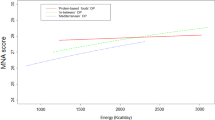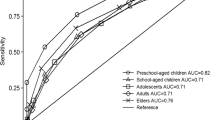Abstract
Background/Objectives:
The aim of this study was to evaluate the feasibility of the suggested trans-European methodology for undertaking representative dietary surveys among schoolchildren: 2 × 24-h dietary recalls (24-HDRs) combined with a food-recording booklet, using EPIC-Soft (the software developed to conduct 24-HDRs in the European Prospective Investigation into Cancer and Nutrition (EPIC) Study) pc-program.
Subjects/Methods:
A total of 75 children aged 7–8 years and 70 children aged 12–13 years old were recruited through the Civil Registration System in Denmark, and 57 children aged 7–8 years and 47 children aged 12–13 years were recruited through schools in Spain. Each child with one parent completed two face-to-face 24-HDRs, combined with optional use of a food-recording booklet (FRB) to be filled in by the child, a parent or other proxy persons for preparing the recalls. Feasibility was evaluated by questionnaires completed by parents, children and interviewers, and by selected data from the 24-HDRs.
Results:
The face-to-face interviews with the child and a parent together are confirmed as feasible. The children participated actively in the interviews, the oldest children being most active. The children, parents and interviewers agreed that children needed help from the parents, and that parents were of help to the child. In both countries, other proxy persons, such as teachers or the school cafeteria staff, were involved before the interview, and the majority of the parents and children reported that the FRB had been a help for the child during the interview. Further results point at specific needed improvements of the tools.
Conclusions:
The evaluated method is shown feasible in two culturally diverse European populations. However, the feasibility study also points to specific improvements of tools and data collection protocol that are strongly recommended before implementation of the method in each country of a pan-European dietary survey.
This is a preview of subscription content, access via your institution
Access options
Subscribe to this journal
Receive 12 print issues and online access
$259.00 per year
only $21.58 per issue
Buy this article
- Purchase on Springer Link
- Instant access to full article PDF
Prices may be subject to local taxes which are calculated during checkout
Similar content being viewed by others
References
Andersen LF, Lioret S, Brants H, Kaic-Rak A, de Boer EJ, Amiano P et al. (2011) Recommendations for a trans-European dietary assessment method in children between 4 and 14 years. Eur J Clin Nutr 65 (Suppl 1), S58–S64.
Baxter SD (2009). Cognitive processes in children's dietary recalls: insight from methodological studies. Eur J Clin Nutr 63, S19–S32.
Baxter SD, Guinn CH, Royer JA, Hardin JW, Mackelprang AJ, Smith AF (2009). Accuracy of children's school-breakfast reports and school-lunch reports (in 24-h dietary recalls) differs by retention interval. Eur J Clin Nutr 63, 1394–1403.
Baxter SD, Royer JA, Guinn CH, Hardin JW, Smith AF (2008). Origins of intrusions in children's dietary recalls: data from a validation study concerning retention interval and information from school food-service production records. Public Health Nutr 12, 1569–1575.
Baxter SD, Smith AF, Nichols MD, Guinn CH, Hardin JW (2006). Children's dietary reporting accuracy over multiple 24-h recalls varies by body mass index category. Nutr Res 26, 241–248.
Biró G, Hulshof KFAM, Ovesen L, Amorim Cruz JA (2002). Selection of methodology to assess food intake. Eur J Clin Nutr 56 (Suppl 2), S25–S32.
Bollella MC, Boccia LA, Nicklas TA, Leafkowitz KB, Pittman BP, Zang EA et al. (1999). Assessing dietary intake in preschool children: the healthy start project—New York. Nutr Res 19, 37–48.
Brussaard JH, Löwik MRH, Steingrımsdottir L, Møller A, Kearney J, De Henauw S, et al., for the EFCOSUM group (2002). A European food consumption survey method—conclusions and recommendations. Eur J Clin Nutr 56 (Suppl 2), S89–S94.
Foster E, Adamson AJ, Anderson AS, Barton KL, Wrieden WL (2009). Estimation of Portion size in children's dietary assessment: lessons learnt. Eur J Clin Nutr 63, S45–S49.
Foster E, Matthews JNS, Lloyd J, Marshall L, Mathers JC, Nelson M et al. (2008). Children's estimates of food portion size: the development and evaluation of three portion size assessment tools for use with children. Br J Nutr 99, 175–184.
Foster E, Matthews JNS, Nelson M, Harris J, Mathers JC, Adamson AJ (2006). Accuracy of estimates of food portion size using food photographs—the importants of using age-appropriate tools. Public Health Nutr 9, 509–514.
Gewa CA, Murphy SP, Neumann CG (2007). Out-of-Home Food Intake Is Often Omitted from Mothers’ recalls of School Children's Intake in Rural Kenya. J Nutr 137, 2154–2159.
Guinn CH, Baxter SD, Hardin JW, Royer JA, Smith AF (2008). Intrusions in children's dietary recalls: the roles of BMI, sex, race, interview protocol, and social desirability. Obesity 16, 2169–2174.
Moreno LA, Kersting M, de Henauw S, Gonza’lez-Gross M, Sichert-Hellert W, Matthys C et al. (2005). How to measure dietary intake and food habits in adolescence: the European perspective. Int J Obes 29, S66–S77.
Slimani N, Deharveng G, Charrondieère RU, van Kappel AL, Ocké MC, Welch A et al. (1999). Structure of the standardized 24-h recall interview used as reference method in the 22 centers participating in the EPIC project. Comput Methods Programs Biomed 58, 252–266.
Slimani N, Kraaks R, Ferrari P, Casagrande C, Clavel- Chapelon F, Lotze G et al. (2002). European Prospective Investigation into cancer and nutrition (EPIC) calibration study: rationale, design and population. Public Health Nutr 5, 1125–1145.
Sobo EJ, Rock CL (2001). ‘You Ate All That!?’: Caretaker-Child Interaction during Children Assisted dietary Recall Interviews. Med Anthropol Q 15, 222–244.
Sobo EJ, Rock CL, Neuhouser ML, Maciel TL, Neumark-Sztainer D (2000). Caretaker-child Interaction during children's 24-h dietary recalls: Who contributes what to the recall record. J Am Diet Assoc 100, 428–433.
Trolle E, Amiano P, Ege M, Bower E, Lioret S, Brants H et al. (2011). Evaluation of 2 × 24-h dietary recalls combined with a food-recording booklet, against a 7-day food-record method among schoolchildren. Eur J Clin Nutr 65 (Suppl 1), S77–S83.
van Assema P, Glanz K, Martens M, Brug J (2007). Differences between parents’ and adolescents’ perceptions of family food rules and availability. J Nutr Educ Behav 39, 84–89.
Ventura AK, Loken E, Mitchell DC, Smiciklas-Wright H, Birch LL (2006). Understanding reporting bias in the dietary recall data of 11-year-old girls. Obesity 14, 1073–1084.
Warren JM, Henry CJK, Livingstone MBE, Lightowler HJ, Bradshaw SM, Perwaiz S (2003). How well do children aged 5–7 years recall food eaten at school lunch? Public Health Nutr 6, 41–47.
Acknowledgements
We thank the interviewers in Denmark, Anne Arendt, Mia Hjort Frandsen and Inger Merete Licht Hansen, and the data management team, Karsten Kørup, Henrik Hartkopp, Karin Hess Ygil and Tue Christensen. We also thank the participating children, parents and other proxy persons in Spain-BC and Denmark. The content of this article reflects only our views, and the Community is not liable for any use that may be made of the information contained therein. The Community funding under the Sixth Framework Program for the EFCOVAL Project is acknowledged (FOOD-CT-2006-022895).
Author information
Authors and Affiliations
Consortia
Corresponding author
Ethics declarations
Competing interests
The authors declare no conflict of interest.
Rights and permissions
About this article
Cite this article
Trolle, E., Amiano, P., Ege, M. et al. Feasibility of 2 × 24-h dietary recalls combined with a food-recording booklet, using EPIC-Soft, among schoolchildren. Eur J Clin Nutr 65 (Suppl 1), S65–S76 (2011). https://doi.org/10.1038/ejcn.2011.89
Published:
Issue Date:
DOI: https://doi.org/10.1038/ejcn.2011.89
Keywords
This article is cited by
-
Feasibility of dietary assessment methods, other tools and procedures for a pan-European food consumption survey among infants, toddlers and children
European Journal of Nutrition (2015)
-
Current Trends in Childhood Obesity Research
Current Nutrition Reports (2012)
-
Rationale and methods of the European Food Consumption Validation (EFCOVAL) Project
European Journal of Clinical Nutrition (2011)
-
Evaluation of 2 × 24-h dietary recalls combined with a food-recording booklet, against a 7-day food-record method among schoolchildren
European Journal of Clinical Nutrition (2011)
-
Feasibility of repeated 24-h dietary recalls combined with a food-recording booklet, using EPIC-Soft, among preschoolers
European Journal of Clinical Nutrition (2011)



